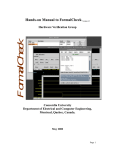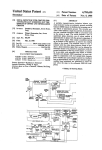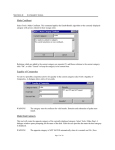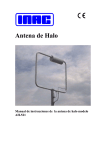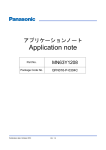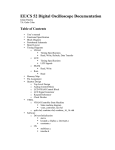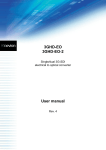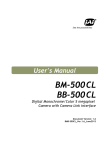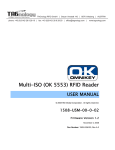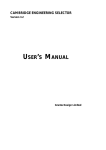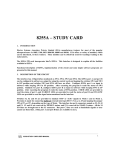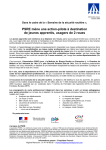Download FormalCheck - Department of ECE
Transcript
Hands-on Manual to FormalCheck
Version 2.3.2
FormalCheck
Hardware Verification Group
Concordia University
Department of Electrical and Computer Engineering
Montreal, Quebec, Canada.
July 2008
Page 1
TABLE OF CONTENTS
Page No.
Preface
5
Audience
5
1.
Introduction
6
2
Verifying Techniques used in FormalCheck
9
3
FormalCheck Project
9
Queries (properties + constraints)
9
Pros and Cons of using Constraints
16
Checking for Overconstraint
16
Stepwise Procedure of Verifying a Design in FormalCheck
17
Step 1 (Initializing Step)
17
Step 2 (Saving the Project)
18
Step 3 (Opening a file: optional)
18
Step 4 (Compiling the Verilog/VHDL design - BUILD)
18
Step 5 (Adding a Constraint).
19
Step 6 (Create/Edit Query)
20
Step 7 (Verify Query)
21
4
Post-Processing Analysis
22
5
Advanced Options
24
New Features
25
AutoCheck
25
Macro
25
Page 2
Page No.
Clock Extraction:
25
Script Interface
25
IMPORTANT BUILD OPTIONS
26
ADVANCED QUERY RUN OPTIONS:
26
THREE VERIFICATION ALGORITHMS
26
A Recommended Procedure for Verification
27
References
28
APPENDICES
29
APPENDIX A
29
The System Settings to Run FormalCheck
29
APPENDIX B
30
FormalCheck File Description
30
Contents of the file README
30
Contents of the file verify.stdout.
31
Contents of the file verify.out
33
Contents of the file query.c
34
APPENDIX C
35
Design Tips (for verification purpose)
36
APPENDIX D
36
The “arbiter” example
36
Description of the Arbiter to be verified
36
Arbiter Basic Specification
38
RTL design
38
Page 3
Page No.
VERIFICATION RESULTS
48
Query-1
48
Query-2
49
Query-3
51
Query-4
52
Query-5
55
.
Page 4
Preface
____________________________________________
Audience:
This guide is written for research students and design engineers who will use
FormalCheck as a tool of hardware verification for the first time. It summarizes the
available material (FormalCheck User Guide, FormalCheck on-line Manual, etc.)
that the manufacturer has provided with the tool.
____________________________________________
Page 5
1. Introduction
Formal verification means a mathematical proof which assures that a property holds of a design
model. The need for “correct” designs in safety-critical applications, coupled with the major cost
associated with products delivered late, are the two of the main reasons behind the recent popularity of formal hardware verification. The verification methods require considerable time and
expertise to verify even fairly simple systems. As a result, practical application has been limited to
a few domains, such as security and safety-critical systems, where ethical or legal requirements
demand the highest assurance of correctness, regardless of the cost [1].
Two well-established approaches to verification are, model checking and theorem proving. Theorem proving means that, given a set of axioms and a theorem formulated in some logic, there
exists a proof generated by the inference system. On the other hand, model checking is a technique that relies on building a finite model of a system and checking that a desired user-defined
property holds in the model [2]. FormalCheck is a model checker, designed to help alleviate the
functional verification bottleneck.
SPEC
RTL
Queries = Properties + Constraints
Compile
Model Checking Engine
Pass or Fail
FIG 1.1: FormalCheck Verification procedure [3]
FormalCheck supports the synthesizable subsets of Verilog and VHDL hardware design languages. The source code does not need to be modified for the sake of verification. The user sup-
Page 6
plies FormalCheck with a set of queries to be verified on the design model. The queries are simply
statements (formalizations) of important behaviors described in the specification.
FormalCheck aids the user by automatically back referencing each error to the offending line to
the source code. The errors can be fixed and the source recompiled without leaving the tool. The
tool explores all possible input scenarios, guaranteeing that no bugs are missed for lack of vectors.
It is common to wait for the test bench to be completed before starting simulation and a complete
test bench is only created at the chip level. With FormalCheck, verification can be started as soon
as the first block is designed and the first query is written. This speeds up the design cycle by
catching the bugs at an earlier stage and also reduce the verification effort. In short, “FormalCheck model checker can be used when the design is fluid or only partially defined” [3].
QUERY
ACTIVE
free fence
PRUNED
S Y S T E M
FIG 1.2: Localization Reduction algorithm[3]
“It is of paramount importance that the tool be able to reduce the model automatically relative to
the property under check, to the greatest extent possible” [3]. FormalCheck uses two approaches
of reduction algorithm (1-step and iterative). Most of the reductions tend to be property-dependent localization reductions [5], in which the part of the design model that are irrelevant to the
property being checked, are abstracted away. In FormalCheck, localization reduction is applied
dynamically. At each step of the algorithm, the model is adjusted by advancing its “free fence”
Page 7
(please refer to the Figure 1.2) of induced primary inputs, in order to discard spurious counter
examples to the stated query [5].
1-step reduction looks at the dependency graph and removes any portion of the design from the
verification proof that cannot affect the outcome of the query. This algorithm propagates constants
contained in the design or in the input assumptions to further reduce the design.
An additional level of reduction can be achieved by Iterative Reduction algorithm. It takes an
attempt to find a small portion of the design that can be used to verify the current query. This technique guarantees that queries proven to be true on the small portion of the design would also be
true for the entire design. This algorithm can be run with or without a user-supplied starting point
(reduction seed) and can reduce the state space of the design by several orders of magnitude,
allowing larger designs to be verified.
This tool checks if a change (by the user) could affect the outcome of the verification. If not, it
marks the query as proven by the previous runs. This unique capability reduces the regression
time. Through FormalCheck’s Back-Reference utility, a click on an error in the waveform pops up
the source with the cursor on the line that caused the error.
Specification
Queries
HDL Code
Automatic
Back-Reference
to error.
FormalCheck
Errors?
YES
NO
Design Verified !!
FIG 1.3: FormalCheck Verification Cycle [6]
Page 8
2. Verifying Techniques used in FormalCheck
To use either the Graphical User Interface (GUI) or the Command Line Version, one must aware
of the functionality of the each step to wisely use the different advanced options provided by
FormalCheck. The following literature refers to the GUI version of FormalCheck tool.
Note: If anyone already has some experience with FormalCheck, can skip this
chapter and can have a look at the chapter 4 (stepwise procedure) in order
to just remind him/herself of the tool
FormalCheck Project:
A FormalCheck project is a container (directory structure) that holds all information relevant to
the verification [6]. One may start the tool either by opening an existing project or by creating a
new one. A project (.fpj) file contains the following information:
• pointer to the model design.
• necessary information to compile the design (i.e. HDL language, top
level entity/module name, hierarchical dependencies, etc.).
• data structure built for the verification.
• queries (properties + constraints)
• result of the verification of the queries.
Queries (properties + constraints):
Existing model-checkers use some form of CTL (Computation Tree Logic) to define properties
[3]. The idea of using a logic was discarded my FormalCheck, because this approach is sometimes hard to be defined for the general users. In FormalCheck, each property is defined using
one of a small set of templates, each with a clear intuitive and simple semantics and correctly as
impressive as the class of omega ( ω ) automata. Of course, what is gained in simplicity is lost in
flexibility [3].
A property is verified if and only if no failures are found after exploring all reachable states and
possible input combinations [6].
Page 9
ENABLING
CONDITION
FULFILLING
CONDITION
DISCHARGING
CONDITION
FIG 2.1: Property Panel, showing essential features.
The above figure defines a property which checks that after each time the designated enabling
condition is enabled, the designated fulfilling condition holds continuously unless the discharging
condition becomes true [3].
“Fulfill at Discharge” option is used when it is necessary to require the Fulfilling Condition concurrently with the Discharging Condition.
Table 1: Explanation of the option “Fulfill at Discharge”
Regular Fulfil and Discharge condition
With option: Fulfill at Discharge (Figure 2.1)
Example: Always (A) Fulfilling Condition
Unless (B=1) Discharging Condition
Example: Always (A)
Fulfilling Condition
Unless After (B=1) Discharging Condition
Explanation: The Fulfilling Condition will
discharge when B=1.
Explanation: The Fulfilling Condition will
discharge when B becomes equal to 1,
while A still holds.
Page 10
Property (safety, liveness):
1. Safety-This kind of property ensures that nothing “bad” happens. The Safety property fails if
the undesired behavior is exhibited in any state which is reachable with the phase state active
[6].
There are two kinds of Safety property in FormalCheck:
a) Never
b) Always
Name of the Signal
0 is equvalent to green
(according to the design)
(traffic_light.direction[0] == 0) && (traffic_light.direction[1] == 0)
Relation Operator
Root Module Name
FIG 2.2: A property in FormalCheck: “Light is never green in both directions”
a) Never: “FormalCheck will explore all possible inputs and reachable states to verify that
the condition can NEVER occur” [6].
Figure 2.2 shows, how one can specify a property in FormalCheck. This can be done
either my writing manually or with the help of buttons (signal selection).
b) Always: “FormalCheck will explore all possible inputs and reachable states to verify
that the condition can NEVER be false” [6].
2. Liveness- This type of property guarantees that eventually something “good” happens.
“A Liveness property fails if there exists a sequence of inputs which can postpone
the required behavior indefinitely. Since all designs are finite state, a liveness
failure amounts to finding a cycle of reachable states where the required behavior
does not occur” [6]. FormalCheck defines three kinds of liveness property:
a) Eventually
b) Eventually Always
c) Strong Liveness
Page 11
FIG 2.3: Property panel with an Eventual Property.
a) Eventually: The Fulfilling Condition must eventually become true. However, it does
not have to remain true all the time. The above eventual liveness property can be written
in words as follows:
After (direction(0) = GREEN)
Eventually (direction (0) = RED)
b) Eventually Always: This is like steady state “Eventually” property. The Fulfilling Condition must remain true (Steady State) at the time of discharging. “It does not have to
reach steady state within any time limit and may become true and then false several
times before it reaches the steady state” [6].
c) Strong Liveness: Strong liveness differs from the other liveness property by its Enabling
Condition. Here, the Enabling Condition is allowed to be checked repeatedly upon the
failure of fulfilling condition.
Page 12
Table 2: The Difference Between Strong Liveness and Eventually
Strong Liveness
Eventually
Format: After (event A)
Format: If Repeatedly (event A)
(Enabling Condition)
(Enabling Condition)
Eventually (event B)
Eventually (event B)
(Fulfilling Condition)
(Fulfilling Condition)
The Enabling Condition need to be satisfied along the failure cycles.
The Enabling Condition need not be satisfied along the failure cycles. The Enabling
Condition may be satisfied before the failure cycle is entered.
Both Enabling and Fulfilling Condition
are required for Strong Liveness property.
When Enabling Condition is absent, the
Fulfilling Condition is active until it is discharged (if ever).
Computationally not simple
Computationally simpler.
Constraint: In FormalCheck, design constraints are defined using a companion set of templates
(property templates and constraint templates are paired), and each check on a design
model is performed in the context of a set of properties and constraints, termed “query”
[3]. All the constraints belonging to the project are listed in the Constraint Library panel
(please refer to Figure 3.3). Constraints limit the state space of a design model.
~X
X
1111111111
0000000000
0000000000
1111111111
0000000000
1111111111
0000000000
1111111111
0000000000
1111111111
0000000000
1111111111
0000000000
1111111111
0000000000
1111111111
0000000000
1111111111
0000000000
1111111111
0000000000
1111111111
0000000000
1111111111
FIG 2.4: The Effect of Constraints in the Reachable State Space [6]
Page 13
Let us assume that, the Figure 2.4 is the total reachable space of a variable X for some design
model. The constraint to be added as “X is true always”. The area with the thick boundary is then
excluded from verification as it belongs to negative X. If we put constraints to some signals which
includes a feature of the design, then that will not be verified and this situation is called “Overconstrained”.
WARNING: We should be careful about the model being not OVERCONSTRAINED.
There are 2 types of general constraints:
i) Safety (never, always)
ii) Fairness (eventually, strong fairness)
Safety constraints are the constraints applied with the safety property and the fairness constraints are applied with the liveness property of the query.
Constraint SHORTCUTS: Constraint Shortcuts are provided by the tool to use as readymade constraints. There is also “general” constraint in order to define any other
kind of constraints. Shortcuts are only allowed for the primary inputs.
i) Assignment
ii) Clock
iii) Constant
iv) Reset/Repeat
i) Assignment: An input signal always takes the value of an expression. The expression
may contain internal signals, but the signal must be a primary input.
ii) Clock: This is a very important constraint. It is an oscillating signal and FormalCheck
detects the rising and falling edge of the signal. Example, design.CLK == rising (Verilog)
Root module. signal_name
FIG 2.5: The usage of Clock Constraint
Page 14
During the verification, this constraint can simulate the behavior of the clock ticks.
iii) Constant: It assumes a signal to have a constant value.
iv) Reset/Repeat: This a very useful constraint. It is used to constrain a signal to a userdefined waveform. The waveform may be an one shot waveform or a repeat (periodic)
one. A signal is first selected, then a waveform is specified. Each state in which the
selected signal matches, the specified waveform is excluded from the verification. This
constraint can wisely be used for the initialization of all the input signals. But to do
that one should always remember that it is going to be needed to add some lines code
to the original design model.
Example: The following is a Verilog example (portion of a design). The reset/repeat
constrain can be applied to the signal reset_elevator (please refer to the Figure 2.6) to
initialize the signals “direction” and “movement”.
// initialization block
always @(reset_elevator)
begin
if (reset_elevator)
begin
direction = ‘UP;
movement = ‘STOPPED;
end
end
FIG 2.6: The usage of Reset/Repeat Constraint
Page 15
The settings on Figure 2.6 will produce a main_reset signal (passed as a parameter
while instantiating another module instance, and thus, is equivalent to reset_elevator) which
is “high” (logic value 1) for 2 cranks (unit of time) and “low” (logic value 0) for the
rest of the verification period. As the block is active only at positive values of the signal reset_elevator, all the input signals in the block are initialized to the desired values.
Cranks: This is the term FormalCheck uses for “unit of time”.
Pros and Cons of using Constraints:
(+) Constraints limit the state space of a design to be verified.
(+) Constraints can significantly reduce the run time.
(+) One can limit the input by using constraint on it, and thus restrict the design. Any error
in the restricted design is also an error for the total design. So, running a severely
restricted design can give a good early warning concerning the computational complexity of the unrestricted design.
(-) Mutually inconsistent constraints can compromise the verification by preventing an
important design flaw being exposed.
Mutually inconsistent: While individually taken, works fine. But simultaneous use impose
contradictory results.
Checking for Overconstraint:
When the properties are overconstraint, the verification result comes as “Vacuous”. It
means, the Enabling Condition of the property was never satisfied. Because,
1. The Enabling Condition was wrongly formed.
2. The verification engine could not reach a state where the Enabling Condition
was satisfied.
3. Inconsistent definitions while forming constraints. Like, X=1 && X=0.
The following are some procedures to solve problems with constraints:
• The only conclusive way to check that a design is not overconstraint is to convert all constraints to their corresponding properties and verify these properties on the model that
derives the inputs of the given design,
• If -DVACCHECK (please refer to page 8-8 on FormalCheck User’s Guide, reference no.
6) fails, one can apply -DVACCHECK “run option” (Query panel) to successive subsets of the constraints until a small mutually inconsistent subset is identified.
• One can check “Missing value Report” for values some signals never attain.
Page 16
3. Stepwise Procedure of Verifying a Design in FormalCheck
Step 1 (Initializing Step).
FIG 3.1: Design Model Panel (for Step 1)
PROJECT
NEW/OPEN
This will invoke “Design Model Panel”.
• Name of the project has to be provided. (“Title”).
• Design language has to be chosen (VHDL or Verilog).
• For VHDL (.vhd/.vhdl): Root Entity (mandatory)
Architecture (mandatory)
• For Verilog (.v): Root Module (mandatory)
Build Option (optional)
ADD
This will invoke “Select Design File Panel”.
• A design file (same language chosen before) has to be selected.
• Option “SAVE LIST”: This will create a text file that contains a list of file
names of the design model files that are currently displayed on the panel.
• Option “NOTES”: This will allow to write notes about the project.
Page 17
Step 2 (Saving the Project).
PROJECT
SAVE / SAVE AS
FormalCheck uses the extension “.fpj” for the files containing the project. The user
has to enter a name for the file.
Step 3 (Opening a file: optional).
FILE
OPEN
This is not a mandatory step for the verification process. But, it allows to debug
syntax error (edit) the design (Verilog/VHDL).
FIG 3.2: Running the Build option on an example (for Step 4)
Step 4 (Compiling the Verilog/VHDL design - BUILD).
PROJECT
BUILD
“Build” option is the first main step towards verification. Whenever any change in
the design is made, BUILD is necessary, so as FILE-SAVE.
The following three actions are performed implicitly by “Build”:
i) Compilation of the design (Verilog or VHDL)
ii) Post-Processing of the netlist.
iii) Processing of the behavioral description.
Page 18
Compilation errors are highlighted in the Diagnostic region, and then are hyperlinks. Clicking on an error will highlight the source line in the edit region that
caused the error.
Note: At the end of this Step 4, the project has to be saved once more (repetition
of Step 2
FIG 3.3: The Constraint Library Panel (for Step 5)
Step 5 (Adding a Constraint).
PROJECT
CONSTRAINT LIBRARY
This will invoke “Constraint Library” panel (Figure 3.3). Constraints limits the
state place of a design model that is verified [6].
Note: Please refer to the previous chapter for more details on CONSTRAINTS.
Page 19
Step 6 (Create/Edit Query).
QUERY
NEW / EDIT
A query must contain one or more properties. The procedure to write properties are
explained in the previous chapter. A new query also automatically contains any
constraints marked as default in the constraint library. Additional constraints can
be added or removed manually.
Default Constraint: “A default constraint is a constraint that will be automatically
applied to all new queries in a project. A constraint marked as default will not be
applied to any pre-existing queries unless specified manually. A non-default constraint can be manually added to any query” [6].
Allows to keep notes on Project, Query , Constraints and State Variab
List of Properties
for the query named
ElevatorDoor
List of Constraints
Symbolic BDD
Explicit State Enumeration
Auto-Restrict
1-Step
Iterated
FIG 3.4: The “Query” Panel and Its Features (for Step 6)
Page 20
Four main steps in the “Query” panel to remember:
1. Name of the property.
2. Type of property.
3. Insertion of logic in Enabling Condition, Fulfilling Condition and/or Discharging Condition.
4. Taking care of Constraints.
“Fulfill Delay”: A delay can be added between the Enabling Condition and the checking
of the Fulfilling Condition. This delay is specified as an integer that counts the
occurrences of an event which is again specified by a boolean expression written
into the “Of Edge” field (please refer to Figure 3.3, “Property” panel).
“Duration”: The verification windows terminates after a given duration of the Discharging condition becomes true, whichever comes first. The duration is measured by an
integer, same way as the “Fulfill Delay”.
FIG 3.5: The “Query Manager” panel (for Step 7).
Step 7 (Verify Query).
Before starting to verify the query, the user has to save the query as well as the project
(Step 2).
QUERY
QUERY MANAGER
Verify!
The user has to select the desired query from the “Name” column (Figure 3.5)
and press the “verify!” button. FormalCheck will do the rest about verification.
Page 21
4. Post-Processing Analysis
The “Result” column of the “Query Manager” may contain eight possible outcomes. The following is the short description:
(1) New: Indicates a new query, no attempt has been taken to verify it.
(2) Failed: Error has been found in the design and an error track is available for debugging.
(3) Verified!: The query was previously verified.
(4) Running: A verification procedure is currently being processed.
(5) Terminated: The verification process is incomplete (user or some other intervention).
(6) Scheduled: The verification is scheduled by the “Schedule Manager” (refer to the Query
pull down menu).
(7) No Error: No failures have been found, but this is not same as verification. It sometimes
happens while using the auto-restrict algorithm to quickly verify the design.
(8) Vacuous: The Enabling condition is never satisfied, the reason why the Fulfilling
condition was never checked.
Select Signals
FIG 4.1: The Wave Form Window (ODAN).
If the result is “Failed”, then the waveform viewer (the Output Display / Analysis Tool ODAN) is very useful to finish the post-verification analysis. FormalCheck creates 2 files
Page 22
(.HDR and .REC) in the query directory for each failed query and ODAN uses those files to
offer the following capabilities:
• Interactively select a subset to the signals for display.
• Zoom-in on critical areas.
• Select a specific time region to view signal activity in detail.
• Group signals under one label.
If the result is “Vacuous”, then there may be a possibility that it was over-constraint (please
refer to Chapter 2 of this manual).
Page 23
5. Advanced Options
FIG 5.1: Reduction Options panel & Run Options panel
FormalCheck uses a patented localized reduction algorithm to reduce the size of the design
model relative to the property being tested [6]. Among the two algorithms 1-step is used by
default and the iterated algorithm is used for complex designs, because it takes less memory
(more time) to verify the design. This reduction technique finds a portion of the design model
on which it is sufficient to run the verification.
Start As
Input
FIG 5.2: Reduction Manager panel
Page 24
A reduction seed can be provided by the user to further speed up the verification process. The
user designates a candidate portion of the design model by marking its boundary signals Start
As Input. This option disconnects all signals marked as “Start As Input” from the driving expressions and turns them into primary inputs. If some driving expressions really in need of
some of these signals, the algorithm will reinstate them, cutting the design model signals at an
alternate point instead [6].
Note: Iterated reduction does not support Auto-Restrict verification algorithm
Reduction Seed is recommended when Iterated Algorithm is used.
Through the “Make Input” option some signals can be disconnected almost permanently from
their driving expressions, and thus treated as primary inputs. This is the way to isolate a portion
of the design model. In such a condition, if FormalCheck verifies a query, it means that the
same query would also be verified in the full design model.
Note: “Make Input” sometimes creates problems in error tracing if FormalCheck returns
failure.
Through the option “Keep Active”, one can make sure that the signal is not going to be excluded from the verification, no matter what.
Note: If “Keep Alive” is used, it increases the computational cost.
“Clear” option removes any reduction designation from a design element.
New Features:
AutoCheck: AutoCheck is applied as a preverification procedure. It is used in the early design
stages to quickly run on queries in order to find early design bugs. AutoCheck is not a complete
verification procedure as it does not cover the entire state space. (further reference: page 5-9 in
user’s manual: command “formalreadthemanual”).
Macro: Macro is the shorthand version of any expression. It is done by the expression editor.
The procedure is to type or insert any expression and give it a name after pressing “MakeMacro”.
Clock Extraction: While imposing clock constraints, the feature “Clock Extraction” can be
used to reduce verification time in some cases. This option should be tried if the design is synchronous with respect to a single clock edge.
Script Interface: FormalCheck supports user-defined UNIX script to perform tasks, like
automatically generating constraints. (see page 8-7 in users’ manual).
Page 25
IMPORTANT BUILD OPTIONS:
[ -D <parameter>=<value> ]
Allows the value of a Verilog parameter to be set to a different (smaller) value to reduce
the state space. This is necessary for parenthesized RAMs, ROMs, FIFOs, and queues.
[ -W<path> ]
Specifies a single directory to which all the files will be created by FormalCheck.
ADVANCED QUERY RUN OPTIONS:
[ -L<mb> ]
Specifies a limit on memory used. “mb” is memory in megabyte, represented in floating
point notation. 80% limit of user accessible memory is recommended. The verification begins a wrap up sequence (time consuming) when the memory is finished to generate reports.
[ -#hardlimit=<mb> ]
Stops verification without the warp up sequence.
[-DVACCHECK ]
This option verifies if really a query is vacuous. If the result with this option is “verified!”
then the query is vacuous. If a bad cycle is found then the query is not vacuous.
THREE VERIFICATION ALGORITHMS:
• Symbolic State Enumeration (Ordered Binary Decision Diagrams / Symbolic BDD)
• Explicit State Enumeration.
• Auto-Restrict.
Symbolic BDD is generally useful for verifying models with a very large set of
States. But, BDDs become extremely large for the design models with arithmetic expressions.
Explicit State Enumeration is recommended for designs with fewer than 1000 primary inputs/state and which contain a large number of arithmetic expressions. It can find
error in the design faster than the symbolic BDD. This algorithm is preferable for liveness
property.
Auto-Restrict attempts to narrow down the portion of the design where a failure is
likely to be found. It speeds up the verification. But if may give the result “No Errors”. In
this case, the verification has to be performed again with any of the previous two algorithms.
Page 26
A Recommended Procedure for Verification:
At first Symbolic BDD should be used with a time limit. The verification can stop for three reasons.
An error can be found, the time limit can be expired or the verification can be complete. For the
first two reasons, one can do the following:
• Missing value report should be checked.
• Restriction should be added.
• Reduction Manager should be employed.
• Verification should be re-run with Auto-restrict or Explicit State Enumeration.
Note: “Missing Values”: Show the design elements (signals) that are irrelevant to the specific
query
Page 27
References
[1] A.J. Hu. Formal Hardware Verification with BDDs: An Introduction, IEEE Pacific Rim Conference on Communications, Computers, and Signal Processing (PACRIM), pp. 677-682,
1997.
[2] E.M. Clarke and J.M. Wing. Formal Methods: State of Art and Future Directions, CMU Computer Science Technical Report CMU-CS-96-178, August 1996.
[3] R.P. Kurshan. Formal Verification In a Commercial Setting, Bell laboratories, Murry Hill, NJ.
In Design Automation Conference. June, 1997.
[4] R.H. Hardin, Z. Har’EL, R. P. Kurshan, COSPAN, Springer LNCS 1102 (1996), pp. 61-67.
[5] R. P. Kurshan, Computer-Aided Verification of Coordinating Processes, Princeton Univ. Press,
1994.
[6] FormalCheck User’s Guide. Cadence Design Systems. V2.3, August 1999.
Page 28
APPENDIX A
System Settings to Run FormalCheck
To use the FormalCheck tool from Cadence:
1) type from the UNIX prompt:
source /CMC/ENVIRONMENT/formalcheck.env
(this is actually a symbolic link to /CMC/ENVIRONMENT/formalcheck_2004a.env, if
you are sourcing a copy of the .env from your home directory MAKE SURE YOU COPY
THE NEWEST VERSION of the /CMC/ENVIRONMENT/formalcheck.env to your
directory)
2) to start the tool type:
formalcheck -gui (to start the Graphical User Interface version)
formalcheck (to start the command line version)
3) to read the on-line documentation:
in the Main Graphical User Interface window, simply click on the Help button in the upper
left-hand side, a pop-up list will be presented:
Formalcheck Reference Manual
Formalcheck Gui Reference Guide
Related Products
Whats New
About Formalcheck
Selecting any of these will start the Cadence documentation by invoking the Netscape
browser and opening up the selected HTML documents.
For those users who prefer to read PDF format, there is a 343 page manual in:
/CMC/tools/cadence/LDV/doc/fcheck/fcheck.pdf
4) There is a small introductory example and short tutorial to using Formalcheck in the
directory:
/CMC/tools/cadence/LDV/tools/fcheck/examples/chap1_example
This directory contains:
drwxr-xr-x 4 cmcmgr cmcmgr
512 May 29 2001 .
drwxr-xr-x 11 cmcmgr cmcmgr
512 May 29 2001 ..
-rwxr-xr-x 1 cmcmgr cmcmgr 163679 May 29 2001 overview.pdf
drwxr-xr-x 2 cmcmgr cmcmgr
512 May 29 2001 vhdl
drwxr-xr-x 3 cmcmgr cmcmgr
512 May 29 2001 vlog
The overview.pdf file is Chapter 1 of the fcheck.pdf document.
The directories vhdl and vlog contain the source code for the example used in the introductory example.
Page 29
APPENDIX B
FormalCheck Files Description
The following is the list of files created in the directory called .<priject_name> (the name
used for the project.
DIRECTORY .crd_project.fpj
FIG 1: SnapShot of the Directory .crd_project.fp
Contents of the file README
All the file contained in this directory and below are considered part of the FormalCheck
project. Changing anything in this directory or its children could result in corrupting your
verification results.
Page 30
DIRECTORY Query_1
FIG 2: SnapShot of the Directory Query_1
Contents of the file verify.stdout
model M: FCHECK bcy0
model unM: FCHECK.C_B_clk FCHECK.C_B_reset
model M_p:
model M_o: .environment_._H15_road_B_._VD5_state___0__1__[1]
M_o+: .environment_._H15_road_B_._VD5_state___0__1__[0]
M_o+: .environment_._H14_road_A_._VD5_state___0__1__[1]
M_o+: .environment_._H14_road_A_._VD5_state___0__1__[0]
pruned:
.environment__ENV
.environment_.__fi_status_A_[0]
.environment_.__fi_status_A_[1]
.environment_.status_A_[0]
.environment_.status_A_[1]
.environment_.__fi_test_
.environment_.test_
.environment_.__fi__VD0__T161___0__2__[0]
.environment_.__fi__VD0__T161___0__2__[1]
.environment_.__fi__VD0__T161___0__2__[2]
.environment_._VD0__T161___0__2__[0]
.environment_._VD0__T161___0__2__[1]
.environment_._VD0__T161___0__2__[2]
.environment_._H13_police_
.environment_._H14_road_A_.__fi_status_[0]
Page 31
.environment_._H14_road_A_.__fi_status_[1]
.environment_._H14_road_A_.status_[0]
.environment_._H14_road_A_.status_[1]
.environment_._H14_road_A_.__fi__VD5_state___0__1__[0]
.environment_._H14_road_A_.__fi__VD5_state___0__1__[1]
.environment_._H14_road_A_._H4__I3
.environment_._H14_road_A_._H5__I4
.environment_._H14_road_A_._H6__I5
.environment_._H15_road_B_.__fi_status_[0]
.environment_._H15_road_B_.__fi_status_[1]
.environment_._H15_road_B_.status_[0]
.environment_._H15_road_B_.status_[1]
.environment_._H15_road_B_.__fi__VD5_state___0__1__[0]
.environment_._H15_road_B_.__fi__VD5_state___0__1__[1]
.environment_._H15_road_B_._H4__I3
.environment_._H15_road_B_._H5__I4
.environment_._H15_road_B_._H6__I5
.environment_._H16_col_
.environment_._H17_starv_
.environment_._H18__I12
.environment_._H19__I13
.environment_._H20__I14
.environment_._H21__I15
.FCHECK.C_B_reset
active:
.FCHECK.P_collision
.bcy0
free:
.environment_._H14_road_A_._VD5_state___0__1__[0]1 free choices
.environment_._H14_road_A_._VD5_state___0__1__[1]1 free choices
.environment_._H15_road_B_._VD5_state___0__1__[0]1 free choices
.environment_._H15_road_B_._VD5_state___0__1__[1]1 free choices
product of free choices=1
free:
.environment_1x1x1x1=1 free choices
product of free choices=1
looking for:
400486bde2e4888a96a0765ca3de8bc06f3d7426b004e4b0394012c88d522073c4344bc5dd17fdb12a43dd391da3ae8bd3b78a0eb6
ad72a55f955107
FCkillMonitor 9771: PIDS is 9773
Page 32
Contents of the file verify.out
9771
Verification Server: enterprise.ece.concordia.ca 9771
SunOS enterprise.ece.concordia.ca 5.5.1 Generic sun4u sparc
cospan -I/CMC/tools/formalcheck2.1/SOLARIS/include environment_.sr -Ks -#caseonedflt -#varlines -#nmi -#missingasgn -#nocaseonedflterr -#shortfloat=3 -#status -#dupstvars -#hotunroot -#hotback -#Msuperset -b -q -#csplit #pthreshold=1e3,50 -#rmc -#flow -#disconnect -#slowdisconnect=4 query.sr
cospan: Version 8.23.24 (Bell Laboratories) 27 May 1998
Iterative run for option -q
Iteration 0:
++++++++++++++++++
cospan: Version 8.23.24 (Bell Laboratories) 27 May 1998
+ sr_E -I/CMC/tools/formalcheck2.1/SOLARIS/cospan -#caseonedflt -#varlines -#nmi -#missingasgn -#nocaseonedflterr -#shortfloat=3 -#status -#dupstvars -#hotunroot -#hotback -#Msuperset -#pthreshold=1e3,50 -#flow -#disconnect #slowdisconnect=4 -I/CMC/tools/formalcheck2.1/SOLARIS/cospan -I/CMC/tools/formalcheck2.1/SOLARIS/include
environment_.sr -Ks -#caseonedflt -#varlines -#nmi -#missingasgn -#nocaseonedflterr -#shortfloat=3 -#status -#dupstvars -#hotunroot -#hotback -#Msuperset -b -#reduction -#pthreshold=1e3,50 -#flow -#disconnect -#slowdisconnect=4
query.sr -#caseonedflt -#varlines -#nmi -#missingasgn -#nocaseonedflterr -#shortfloat=3 -#status -#dupstvars -#hotunroot -#hotback -#Msuperset -#pthreshold=1e3,50 -#flow -#disconnect -#slowdisconnect=4 -#caseonedflt -#varlines #nmi -#missingasgn -#nocaseonedflterr -#shortfloat=3 -#status -#dupstvars -#hotunroot -#hotback -#Msuperset -#reduction -#pthreshold=1e3,50 -#flow -#disconnect -#slowdisconnect=4
Status: Begin parsing at 0.01 sec 0 megabytes.
query.rf: Wed Sep 22 14:31:28 1999
environment_.sr: Wed Sep 22 14:31:31 1999
./environment__ENV.sr: Wed Sep 22 14:31:31 1999
query.sr: Wed Sep 22 14:31:29 1999
/CMC/tools/formalcheck2.1/SOLARIS/include/QRY.h: Wed Jul 29 14:17:28 1998
/CMC/tools/formalcheck2.1/SOLARIS/include/QRY+.h: Wed Jul 29 14:17:27 1998
/CMC/tools/formalcheck2.1/SOLARIS/include/gui.h: Wed Jul 29 14:17:28 1998
Status: Begin checks and tree rewrites at 0.15 sec 1.37626 megabytes.
query.rf: list entry count: unM 2 M 2 M_o 4
568 pruned, 1 active, 4 freed by reduction
284 data variables declared or with width >= -#databits=4
4 selection/local variables
1 bounded state variables: 2 states
0 unbounded state variables
1 boolean cysets
0 boolean recurs
0 free selection/local variables: 1 selections/state
2 kill/free optimization actions
2 variable assignments driven by kills
886 variable reference clippings, 655 expression clippings
2 vector bitwise comparisons expanded
0 pausing processes
0 non-deterministic (non-free) selection/local variables
1 selections/state (maximum)
1 total selections/state (maximum)
sr_E: Equivalent reduction, Task performed! (older run)
+ exit 3
FormalCheck Verification Finished
Wed Sep 22 14:31:53 EDT 1999
Page 33
Contents of the file query.c
static char WHAT[]="@(#)query.c Wed Sep 22 05:49:05 1999";
#ifndef Int
#define Int int
#endif
#define String int
#define BYTESIZE 8
#ifdef HDR
extern
#endif
struct{
struct{
struct{
Int _clk_;
unsigned char U_clk_[2];
Int _reset_;
unsigned char U_reset_[2];
struct{
Int _prev0;
}_91179_clk____;
}_environment__ENV;
struct{
Int ___fi__U2_r_state_;
Int ___fi__U3_r_state_;
struct{
Int _9983___fi__VD5_state___0__1___0;
Int _9982___fi__VD5_state___0__1___1;
Int _9985__VD5_state___0__1___0;
Int _9984__VD5_state___0__1___1;
struct{
Int _9923___fi_SR_OUT_state__0;
Int _9922___fi_SR_OUT_state__1;
Int _9925_SR_OUT_state__0;
Int _9924_SR_OUT_state__1;
Int _9911___fi_SR_ST_state__0;
Int _9910___fi_SR_ST_state__1;
struct{
Int _st0;
}_9913_SR_ST_state__0;
struct{
Int _st1;
}_9912_SR_ST_state__1;
Int ___fi__T90_;
Int __T90_;
unsigned char U__T90_[2];
Int _9926___fi__Z1_state__1;
Int _9928__Z1_state__1;
}__H6__I5;
}__H14_road_A_;
struct{
................. FILE CONTINUES
Page 34
APPENDIX C
Design Tips (for verification purpose)
One may remember the following:
• One should not use two signals to activate the events in an always block.
correct: always @(posedge clk)
incorrect: always @(posedge clk && reset)
• “Initialization” is not supported by FormalCheck. We used another extra signal “reset”,
propagated through all the modules. The “reset” signal is made active high for only 2
cranks of time and low for ever (Reset/Repeat constraint). The always block activated
by the positive “reset” signal contains the assignments for the initialization.
Note that while specifying the above reset signal one is going to introduce another
“always” block (concurrent block). With two always blocks in the same module, one
should be careful to avoid reassignment of the same signal in the 2 concurrent blocks. This
may greatly affect the verification.
• If design contains internal nondeterministic signals, they should be converted to
primary input of that module because, FormalCheck does not support nondeterministic
internal signals.
• FormalCheck does not support real enumerated data types for Verilog code. But it is
possible to use the key word “define”. For example,
‘define no_cars 0
‘define car_waiting 1
‘define cars_passing 2
‘define traffic_status {no_cars, car_waiting, cars_passing}
Note that the above piece of Verilog code is used just outside the modules (please refer to
the Verilog example in Appendix D).
Page 35
APPENDIX D
The “Arbiter” Example
(Courtesy of Cadence for educational purposes only)
===============================================================================
Description of the Arbiter to be verified:
Req{3:0}
Rot
Am
Arbiter
Ack{3:0}
Ck
Reset
Byp_Req{3:0}
FIG 3: Arbiter Circuit Block Diagram
The circuit arbitrates a shared resource among 4 clients. It features a selectable (clockwise or counter clockwise) polling direction for either a round-robin or an aged-based arbitration scheme. The
circuit also features the ability to bypass requests. The above picture shows the block diagram of
the circuit.
The state diagram of the circuit’s functionality is depicted on the next page.
Page 36
A
(~ReqAReqB)Rot
(~ReqDReqA)Rot
ReqA
Off
~ReqAReqB
IDLE
D
B
Off
Off
Off
~ReqA~ReqBReqC
(~ReqA~ReqBReqC)Rot
(~ReqA~ReqB~ReqC)ReqD
C
Off = ~ReqA~ReqB~ReqC~ReqD
FIG 4: Arbiter State Diagram
Table 1: Arbiter’s I/O Specification
SIGNAL
POLARITY
BRIEF DESCRIPTION
Req[3:0]
1
Client’s Request - Active High
Byp_Req[3:0]
1
Command to Bypass Requests
Active High.
Rot
0/1
0 - Counter -clockwise Rotation
1 - Clockwise Rotation
Am
0/1
Arbitration Mode
0 - Round Robin
1 - Age Based
Ck
Posedge
System Clock
Reset
1
Reset Signal - Active High
Ack[3:0]
1
Acknowledgement - Active High
Page 37
Arbiter Basic Specification:
•
Request inputs (Req[3:0]) are required to be deasserted a minimum of one clock cycle after
the request is acknpwledged.
•
Acknowledge outputs (Ack[3:0]) will remain stable one clock cycle after the corresponding
Request (Req[3:0]) input goes low.
The following are all the necessary verilog files of the RTL design:
===================
RTL design:
arb.h
// *************************************************************************
//
//File:arb.h
// Description:Global Mnemonic Assignments in arbiter
//
// *************************************************************************
//
‘define IDLE4’b0000
‘define GrantA4’b0001
‘define GrantB4’b0010
‘define GrantC4’b0100
‘define GrantD4’b1000
arb.v
// **************************************************
//
//File:arb.v
// Description:Top RTL-Level for arbiter
//
// **************************************************
//
//
// **************************************************
//
// circuit:arb.v
// Description:Arbiter for 4 clients.
//
// **************************************************
//
//
// Files:
//arb.h --‘include "arb.h"
Page 38
//dpath.v -- Decision logic in a small datapath.
//fsm.v -- FSM for arbiter
//age.v -- State to compute the age of a client’s request
//arb.v -- Top RTL-level for arbiter
//arb.fpj -- Project file (arb.fpj.ascii --> text mode project file)
//
//
// *****************************************************************
//
//Brief Functional Description
//
// *****************************************************************
//
// Arb.v arbitrates a shared resource among 4 clients.
//
// A Request "Req_(j)" is eventually acknowledged. Asserting "Ack_(j)"
// after a request is issued may take as little as 1 clock cycle or as
// many as "X" clock cycles. It is expected from the environment that
// each Req_(j) asserted is eventually withdrawn. Removing Req_(j)
// after the acknowledment is issued may take as little as 1 clock cycle
// or as many as "Y" clock cycles. Each Ack_(j) goes away 1 clock cycle
// after Req_(j) is withdrawn.
//
//
modulearb (ck, reset, req, byp_req, rot, am, ack);
input
ck, reset;
input[3:0] req, byp_req;
input
rot, am;
output[3:0] ack;
// *****************************************************************
//
//Brief Description on I/O signals
//
// *****************************************************************
//
// Inputs
// ------// cksystem clock
// resetsynchronous reset - Active high
// reqbus requests from clients
// byp_reqcommand to bypass requests from clients
// rotarbiter’s rotation direction
//-----------+--------------------// rot Value | Polling Direction
//-----------+--------------------// 0 | CounterClockwise
// 1 | Clockwise
//
// amarbitration mode (scheme)
//-----------+--------------------// am Value | Arbitration Scheme
//-----------+--------------------// 0 | Round Robin
// 1 | Aged-based
Page 39
//
// Outputs
// ------// ackacknowledgement of bus grants back to clients
//
// **************************************************************
// **************************************************************
// Internal wires
// **************************************************************
wireselA, selB, selC, selD, aged;
wire[2:0]AgeA, AgeB, AgeC, AgeD;
wire[3:0]requests, ack;
wirereqA, reqB, reqC, reqD;
assign aged = am;
assign reqA = ~ byp_req[0] & req[0];
assign reqB = ~ byp_req[1] & req[1];
assign reqC = ~ byp_req[2] & req[2];
assign reqD = ~ byp_req[3] & req[3];
assign requests = { {reqD}, {reqC}, {reqB}, {reqA} };
fsm FSM (.ck(ck), .reset(reset), .reqA(selA), .reqB(selB),
.reqC(selC), .reqD(selD), .state(ack));
dpath DP (.AgeA(AgeA), .AgeB(AgeB), .AgeC(AgeC), .AgeD(AgeD),
.rot(rot), .aged(aged), .req(requests), .lastGrant(ack),
.selA(selA), .selB(selB), .selC(selC), .selD(selD) );
age AGE (.ck(ck), .reset(reset), .req(requests), .ack(ack),
.AgeA(AgeA), .AgeB(AgeB), .AgeC(AgeC), .AgeD(AgeD));
endmodule // arb
fsm.v
// *************************************************************************
//
//File:fsm.v
// Description:Arbiter’s Finite State Machine
//
// *************************************************************************
modulefsm (ck, reset, reqA, reqB, reqC, reqD, state);
inputck, reset, reqA, reqB, reqC, reqD;
output[3:0] state;
reg[3:0] state;
always @(posedge ck)
begin
if (reset)
state <= ‘IDLE;
Page 40
else
begin
case (state)
‘IDLE ://Waiting for Requests
begin
if ( (reqA | reqB | reqC | reqD) == 1’b1)
begin
if (reqA)
state <= ‘GrantA;
else if (reqB)
state <= ‘GrantB;
else if (reqC)
state <= ‘GrantC;
else if (reqD)
state <= ‘GrantD;
end
end
‘GrantA :
begin
if ( (reqA | reqB | reqC | reqD) == 1’b0)
state <= ‘IDLE;
else
begin
if (reqB)
state <= ‘GrantB;
else if (reqC)
state <= ‘GrantC;
else if (reqD)
state <= ‘GrantD;
end
end
‘GrantB :
begin
if ( (reqA | reqB | reqC | reqD) == 1’b0)
state <= ‘IDLE;
else
begin
if (reqA)
state <= ‘GrantA;
else if (reqC)
state <= ‘GrantC;
else if (reqD)
state <= ‘GrantD;
end
end
‘GrantC :
begin
if ( (reqA | reqB | reqC | reqD) == 1’b0)
state <= ‘IDLE;
else
begin
if (reqA)
state <= ‘GrantA;
else if (reqB)
state <= ‘GrantB;
else if (reqD)
Page 41
state <= ‘GrantD;
end
end
‘GrantD :
begin
if ( (reqA | reqB | reqC | reqD) == 1’b0)
state <= ‘IDLE;
else
begin
if (reqA)
state <= ‘GrantA;
else if (reqB)
state <= ‘GrantB;
else if (reqC)
state <= ‘GrantC;
end
end
endcase
end
end
endmodule // fsm
dpath.v
// *************************************************************************
//
//File:dpath.v
// Description:Datapath with Grant’s Selection Logic
//
// *************************************************************************
//
‘include "arb.h"
module dpath (AgeA, AgeB, AgeC, AgeD, rot, aged, req,
lastGrant, selA, selB, selC, selD);
input[2:0]AgeA, AgeB, AgeC, AgeD;
inputrot, aged;
input[3:0]req, lastGrant;
outputselA, selB, selC, selD;
//
// ****************************************************************
//
//Internal wires
//
// ****************************************************************
//
wire A_ge_B, A_lt_B, A_ge_C, A_lt_C, A_ge_D, A_lt_D;
wire B_ge_A, B_lt_A, B_ge_C, B_lt_C, B_ge_D, B_lt_D;
Page 42
wire C_ge_A, C_lt_A, C_ge_B, C_lt_B, C_ge_D, C_lt_D;
wire D_ge_A, D_lt_A, D_ge_B, D_lt_B, D_ge_C, D_lt_C;
wire selA_pri0, selA_pri1, selA_pri2, selA_pri3;
wire selB_pri0, selB_pri1, selB_pri2, selB_pri3;
wire selC_pri0, selC_pri1, selC_pri2, selC_pri3;
wire selD_pri0, selD_pri1, selD_pri2, selD_pri3;
wire selA_pri2_1, selA_pri2_2, selA_pri2_3;
wire selB_pri2_1, selB_pri2_2, selB_pri2_3;
wire selC_pri2_1, selC_pri2_2, selC_pri2_3;
wire selD_pri2_1, selD_pri2_2, selD_pri2_3;
wire selA_pri3_1, selA_pri3_2, selA_pri3_3;
wire selB_pri3_1, selB_pri3_2, selB_pri3_3;
wire selC_pri3_1, selC_pri3_2, selC_pri3_3;
wire selD_pri3_1, selD_pri3_2, selD_pri3_3;
wire reqA, reqB, reqC, reqD;
wire selA, selB, selC, selD;
assign reqA = req[0];
assign reqB = req[1];
assign reqC = req[2];
assign reqD = req[3];
assign A_ge_B = (AgeA >= AgeB) ? 1’b1 : 1’b0;
assign A_lt_B = ~A_ge_B;
assign A_ge_C = (AgeA >= AgeC) ? 1’b1 : 1’b0;
assign A_lt_C = ~A_ge_C;
assign A_ge_D = (AgeA >= AgeD) ? 1’b1 : 1’b0;
assign A_lt_D = ~A_ge_D;
assign B_ge_A = (AgeB >= AgeA) ? 1’b1 : 1’b0;
assign B_lt_A = ~B_ge_A;
assign B_ge_C = (AgeB >= AgeC) ? 1’b1 : 1’b0;
assign B_lt_C = ~B_ge_C;
assign B_ge_D = (AgeB >= AgeD) ? 1’b1 : 1’b0;
assign B_lt_D = ~B_ge_D;
assign C_ge_A = (AgeC >= AgeA) ? 1’b1 : 1’b0;
assign C_lt_A = ~C_ge_A;
assign C_ge_B = (AgeC >= AgeB) ? 1’b1 : 1’b0;
assign C_lt_B = ~C_ge_B;
assign C_ge_D = (AgeC >= AgeD) ? 1’b1 : 1’b0;
assign C_lt_D = ~C_ge_D;
assign D_ge_A = (AgeD >= AgeA) ? 1’b1 : 1’b0;
assign D_lt_A = ~D_ge_A;
assign D_ge_B = (AgeD >= AgeB) ? 1’b1 : 1’b0;
assign D_lt_B = ~D_ge_B;
assign D_ge_C = (AgeD >= AgeC) ? 1’b1 : 1’b0;
assign D_lt_C = ~D_ge_C;
Page 43
//
// Default Selections
//
assign selA_pri0 = (lastGrant == ‘IDLE) & reqA;
assign selB_pri0 = (lastGrant == ‘IDLE) & ~reqA & reqB;
assign selC_pri0 = (lastGrant == ‘IDLE) & ~reqA & ~reqB & reqC;
assign selD_pri0 = (lastGrant == ‘IDLE) & ~reqA & ~reqB & ~reqC & reqD;
//
// Ownership Selections
//
assign selA_pri1 = (lastGrant == ‘GrantA) &
assign selB_pri1 = (lastGrant == ‘GrantB) &
assign selC_pri1 = (lastGrant == ‘GrantC) &
assign selD_pri1 = (lastGrant == ‘GrantD) &
reqA;
reqB;
reqC;
reqD;
//
// Round Robin Selections
//
assign selA_pri2_1 = (lastGrant == ‘GrantB) & ~reqB & (~rot || ~reqC & ~reqD);
assign selA_pri2_2 = (lastGrant == ‘GrantC) & ~reqC & (~rot & ~reqB || rot & ~reqD);
assign selA_pri2_3 = (lastGrant == ‘GrantD) & ~reqD & ( rot || ~reqC & ~reqB);
assign selA_pri2 = (reqA & ~aged) & (selA_pri2_1 | selA_pri2_2 | selA_pri2_3);
assign selB_pri2_1 = (lastGrant == ‘GrantC) & ~reqC & (~rot || ~reqD & ~reqA);
assign selB_pri2_2 = (lastGrant == ‘GrantD) & ~reqD & (~rot & ~reqC || rot & ~reqA);
// Fix assign selB_pri2_3 = (lastGrant == ‘GrantA) & ~reqA & (rot || ~reqD & ~reqC);
assign selB_pri2_3 = (lastGrant == ‘GrantA) & ~reqA & rot;
assign selB_pri2 = (reqB & ~aged) & (selB_pri2_1 | selB_pri2_2 | selB_pri2_3);
assign selC_pri2_1 = (lastGrant == ‘GrantD) & ~reqD & (~rot || ~reqA & ~reqB);
assign selC_pri2_2 = (lastGrant == ‘GrantA) & ~reqA & (~rot & ~reqD || rot & ~reqB);
assign selC_pri2_3 = (lastGrant == ‘GrantB) & ~reqB & ( rot || ~reqA & ~reqD);
assign selC_pri2 = (reqC & ~aged) & (selC_pri2_1 | selC_pri2_2 | selC_pri2_3);
assign selD_pri2_1 = (lastGrant == ‘GrantA) & ~reqA & (~rot || ~reqB & ~reqC);
assign selD_pri2_2 = (lastGrant == ‘GrantB) & ~reqB & (~rot & ~reqA || rot & ~reqC);
assign selD_pri2_3 = (lastGrant == ‘GrantC) & ~reqC & ( rot || ~reqB & ~reqA);
assign selD_pri2 = (reqD & ~aged) & (selD_pri2_1 | selD_pri2_2 | selD_pri2_3);
//
// Age Based Selections
//
assign selA_pri3_1 = (lastGrant == ‘GrantD) & ~reqD & (( rot & A_ge_B & A_ge_C) ||
(~rot & C_lt_A & B_lt_A));
assign selA_pri3_2 = (lastGrant == ‘GrantC) & ~reqC & (( rot & D_lt_A & A_ge_B) ||
(~rot & B_lt_A & A_ge_D));
assign selA_pri3_3 = (lastGrant == ‘GrantB) & ~reqB & (( rot & C_lt_A & D_lt_A) ||
(~rot & A_ge_D & A_ge_C));
assign selA_pri3 = (reqA & aged) & (selA_pri3_1 | selA_pri3_2 | selA_pri3_3);
assign selB_pri3_1 = (lastGrant == ‘GrantA) & ~reqA & (( rot & B_ge_C & B_ge_D) ||
(~rot & D_lt_B & C_lt_B));
assign selB_pri3_2 = (lastGrant == ‘GrantD) & ~reqD & (( rot & A_lt_B & B_ge_C) ||
Page 44
(~rot & C_lt_B & B_ge_A));
assign selB_pri3_3 = (lastGrant == ‘GrantC) & ~reqC & (( rot & D_lt_B & A_lt_B) ||
(~rot & B_ge_A & B_ge_D));
assign selB_pri3 = (reqB & aged) & (selB_pri3_1 | selB_pri3_2 | selB_pri3_3);
// Fix assign selC_pri3_1 = (lastGrant == ‘GrantB) & ~reqB & (( rot & C_ge_D & C_ge_A) ||
assign selC_pri3_1 = (lastGrant == ‘GrantB) & ~reqB & (( rot & C_ge_D & C_ge_A) ||
(~rot & A_lt_C & D_lt_C));
assign selC_pri3_2 = (lastGrant == ‘GrantA) & ~reqA & (( rot & B_lt_C & C_ge_D) ||
(~rot & D_lt_C & C_ge_B));
assign selC_pri3_3 = (lastGrant == ‘GrantD) & ~reqD & (( rot & A_lt_C & B_lt_C) ||
(~rot & C_ge_B & C_ge_A));
assign selC_pri3 = (reqC & aged) & (selC_pri3_1 | selC_pri3_2 | selC_pri3_3);
assign selD_pri3_1 = (lastGrant == ‘GrantC) & ~reqC & (( rot & D_ge_A & D_ge_B) ||
(~rot & B_lt_D & A_lt_D));
assign selD_pri3_2 = (lastGrant == ‘GrantB) & ~reqB & (( rot & C_lt_D & D_ge_A) ||
(~rot & A_lt_D & D_ge_C));
assign selD_pri3_3 = (lastGrant == ‘GrantA) & ~reqA & (( rot & B_lt_D & C_lt_D) ||
(~rot & D_ge_C & D_ge_B));
assign selD_pri3 = (reqD & aged) & (selD_pri3_1 | selD_pri3_2 | selD_pri3_3);
assign selA = selA_pri0 | selA_pri1 | selA_pri2 | selA_pri3;
assign selB = selB_pri0 | selB_pri1 | selB_pri2 | selB_pri3;
assign selC = selC_pri0 | selC_pri1 | selC_pri2 | selC_pri3;
assign selD = selD_pri0 | selD_pri1 | selD_pri2 | selD_pri3;
endmodule // dpath
age.v
// *************************************************************************
//
//File:age.v
// Description:Determines the Age of a Request.
//
// *************************************************************************
//
module age (ck, reset, req, ack, AgeA, AgeB, AgeC, AgeD);
inputck, reset;
input[3:0] req, ack;
output[2:0] AgeA, AgeB, AgeC, AgeD;
wireReqA, ReqB, ReqC, ReqD;
wireAckA, AckB, AckC, AckD;
wireAwon, Bwon, Cwon, Dwon;
reg[2:0] AgeA, AgeB, AgeC, AgeD;
assign Awon = req[0] && ack[0];
assign Bwon = req[1] && ack[1];
assign Cwon = req[2] && ack[2];
assign Dwon = req[3] && ack[3];
always @(posedge ck)
Page 45
begin
if (reset)
begin
AgeA <= 3’d0;
AgeB <= 3’d0;
AgeC <= 3’d0;
AgeD <= 3’d0;
end
else
if (Awon)
begin
AgeA <= 3’d0;
if (req[1])
begin
if (AgeB < 6)
AgeB <= AgeB + 3’d1;
else
AgeB <= AgeB;
end
if (req[2])
begin
if (AgeC < 6)
AgeC <= AgeC + 3’d1;
else
AgeC <= AgeC;
end
if (req[3])
begin
if (AgeD < 6)
AgeD <= AgeD + 3’d1;
else
AgeD <= AgeD;
end
end
if (Bwon)
begin
AgeB <= 3’d0;
if (req[0])
begin
if (AgeA < 6)
AgeA <= AgeA + 3’d1;
else
AgeA <= AgeA;
end
if (req[2])
begin
if (AgeC < 6)
AgeC <= AgeC + 3’d1;
else
AgeC <= AgeC;
end
if (req[3])
begin
if (AgeD < 6)
AgeD <= AgeD + 3’d1;
else
AgeD <= AgeD;
end
end
Page 46
if (Cwon)
begin
AgeC <= 3’d0;
if (req[0])
begin
if (AgeA < 6)
AgeA <= AgeA + 3’d1;
else
AgeA <= AgeA;
end
if (req[1])
begin
if (AgeB < 6)
AgeB <= AgeB + 3’d1;
else
AgeB <= AgeB;
end
if (req[3])
begin
if (AgeD < 6)
AgeD <= AgeD + 3’d1;
else
AgeD <= AgeD;
end
end
if (Dwon)
begin
AgeD <= 3’d0;
if (req[0])
begin
if (AgeA < 6)
AgeA <= AgeA + 3’d1;
else
AgeA <= AgeA;
end
if (req[1])
begin
if (AgeB < 6)
AgeB <= AgeB + 3’d1;
else
AgeB <= AgeB;
end
if (req[2])
begin
if (AgeC < 6)
AgeC <= AgeC + 3’d1;
else
AgeC <= AgeC;
end
end
end
endmodule // age
VERIFICATION RESULTS:
Page 47
Query-1:
Query: NoAck_Unless_Req
------------------------------------------------------------------------------PROPERTIES:
------------------------------------------------------------------------------Property: NoAcks
Type: Always
Always: (arb.ack == 0)
Unless After: (arb.req >= 1) && (arb.ck == rising)
Options: Fulfill at discharge
------------------------------------------------------------------------------CONSTRAINTS:
------------------------------------------------------------------------------Clock Constraint: ck
Signal: arb.ck
Extract: No
Default: Yes
Start: Low
1st Duration: 1
2nd Duration: 1
------------------------------------------------------------------------------Reset Constraint: reset
Signal: arb.reset
Default: Yes
Start: High
Transition Duration Value
Start
2 1
forever 0
-------------------------------------------------------------------------------
RUN OPTIONS:
------------------------------------------------------------------------------Algorithm: Symbolic (BDD)
------------------------------------------------------------------------------REDUCTION OPTIONS:
------------------------------------------------------------------------------Reduction Technique: 1-Step
Reduction Seed: Empty
-------------------------------------------------------------------------------
Page 48
RESULT:
------------------------------------------------------------------------------Verification Query NoAck_Unless_Req VERIFIED! Wed May 10 01:15:50 2000 on server: richards
Query Data:
1.32e3 combinational variables
1.02e3 Possible input combinations per state
20 State variables: 2.1e+06 states
Verification Data:
5 states reached.
State variable coverage: 20 variables, 57.50% average coverage
Search Depth: 5
Real time: 0 minutes 23 seconds
Memory Usage: 5.99654 megabytes
------------------------------------------------------------------------------EXPRESSION MACROS:
------------------------------------------------------------------------------@AckA: arb.ack[0] == 1
@AckB: arb.ack[1] == 1
@AckC: arb.ack[2] == 1
@AckD: arb.ack[3] == 1
@All_Reqs: arb.req == 15
@CkRising: arb.ck == rising
@Multi_Acks: (((arb.ack[3] + arb.ack[2]) + arb.ack[1]) + arb.ack[0]) > 1
@ReqA: arb.req[0] == 1
@ReqB: arb.req[1] == 1
@ReqC: arb.req[2] == 1
@ReqD: arb.req[3] == 1
@ResetDone: arb.reset == finished
Query-2:
Query: Only_One_Ack
There are 4 request inputs and 4 acknowledge outputs in this design.
We want to verify that the arbiter never acknowledges more than one request at
a time.
Ensure P1{NEVER{Ack1 + Ack2 + .... + Ackn >1}}
THIS IS A NEVER PROPERTY.
-------------------------------------------------------------------------------
PROPERTIES:
-------------------------------------------------------------------------------
Page 49
Property: Never_Multiple_Acks
Type: Never
Never: @Multi_Acks
Options:(None)
------------------------------------------------------------------------------CONSTRAINTS:
------------------------------------------------------------------------------Clock Constraint: ck
Signal: arb.ck
Extract: No
Default: Yes
Start: Low
1st Duration: 1
2nd Duration: 1
------------------------------------------------------------------------------Reset Constraint: reset
Signal: arb.reset
Default: Yes
Start: High
Transition Duration Value
Start
2 1
forever 0
-------------------------------------------------------------------------------
RUN OPTIONS:
------------------------------------------------------------------------------Algorithm: Symbolic (BDD)
------------------------------------------------------------------------------REDUCTION OPTIONS:
------------------------------------------------------------------------------Reduction Technique: 1-Step
Reduction Seed: Empty
------------------------------------------------------------------------------RESULT:
------------------------------------------------------------------------------Verification Query Only_One_Ack VERIFIED! Wed May 10 01:16:29 2000 on server: richards
Query Data:
1.32e3 combinational variables
1.02e3 Possible input combinations per state
20 State variables: 2.1e+06 states
Verification Data:
1.11e+04 states reached.
Page 50
State variable coverage: 20 variables, 97.50% average coverage
Search Depth: 20
Real time: 0 minutes 17 seconds
Memory Usage: 5.99654 megabytes
Query-3:
ery: AckA_Width
Checking if the AckA is minimum of 2 clocks wide.
We can later check for AckB, AckC and AckD. Which can be easily done in command
line version.
------------------------------------------------------------------------------PROPERTIES:
------------------------------------------------------------------------------Property: Min_Width_AckA_2clks
Type: Always
After: arb.ack[0] == rising
Always: arb.ack[0] == 1
Options: Fulfill Delay: 0 Duration: 2 counts of
@CkRising
------------------------------------------------------------------------------CONSTRAINTS:
------------------------------------------------------------------------------Constant Constraint: Dont_bypassA
Signal: arb.byp_req[0]
Default: No
Value: 0
------------------------------------------------------------------------------Group Constraint: ReqA
Constraints: ReqA_cant_occur
ReqA_persists
Default: Yes
------------------------------------------------------------------------------Clock Constraint: ck
Signal: arb.ck
Extract: No
Default: Yes
Start: Low
1st Duration: 1
2nd Duration: 1
------------------------------------------------------------------------------Reset Constraint: reset
Page 51
Signal: arb.reset
Default: Yes
Start: High
Transition Duration Value
Start
2 1
forever 0
-------------------------------------------------------------------------------
RUN OPTIONS:
------------------------------------------------------------------------------Algorithm: Symbolic (BDD)
------------------------------------------------------------------------------REDUCTION OPTIONS:
------------------------------------------------------------------------------Reduction Technique: 1-Step
Reduction Seed: Empty
------------------------------------------------------------------------------RESULT:
------------------------------------------------------------------------------Verification Query AckA_Width VERIFIED! Wed May 10 01:17:03 2000 on server: richards
Query Data:
1.32e3 combinational variables
512 Possible input combinations per state
25 State variables: 1e+08 states
Verification Data:
1.54e+04 states reached.
State variable coverage: 25 variables, 96.00% average coverage
Search Depth: 42
Real time: 0 minutes 24 seconds
Memory Usage: 6.0375 megabytes
Query-4:
Query: Acka
This query includes a liveness property and fairness constraint.
It says that eventually there will be an acknowledgment for the request from A.
------------------------------------------------------------------------------PROPERTIES:
-------------------------------------------------------------------------------
Page 52
Property: Eventually_AckA
Type: Eventually
After: @ResetDone && @ReqA && @CkRising
Eventually: @AckA
Options:(None)
------------------------------------------------------------------------------CONSTRAINTS:
------------------------------------------------------------------------------Constant Constraint: Dont_bypassA
Signal: arb.byp_req[0]
Default: No
Value: 0
------------------------------------------------------------------------------Group Constraint: ReqA
Constraints: ReqA_cant_occur
ReqA_persists
Default: Yes
------------------------------------------------------------------------------Group Constraint: ReqB
Constraints: ReqB_cant_occur
ReqB_persists
Default: Yes
------------------------------------------------------------------------------Group Constraint: ReqC
Constraints: ReqC_cant_occur
ReqC_persists
Default: Yes
------------------------------------------------------------------------------Group Constraint: ReqD
Constraints: ReqD_cant_occur
ReqD_persists
Default: Yes
------------------------------------------------------------------------------Constraint Stable_Rotation
Type: Always
After: @ResetDone && @CkRising
Assume Always: arb.rot == stable
Options: (None)
------------------------------------------------------------------------------Constant Constraint: am_zero
Signal: arb.am
Default: No
Value: 0
To make the arbitration mode non age based
Page 53
------------------------------------------------------------------------------Clock Constraint: ck
Signal: arb.ck
Extract: No
Default: Yes
Start: Low
1st Duration: 1
2nd Duration: 1
------------------------------------------------------------------------------Reset Constraint: reset
Signal: arb.reset
Default: Yes
Start: High
Transition Duration Value
Start
2 1
forever 0
-------------------------------------------------------------------------------
RUN OPTIONS:
------------------------------------------------------------------------------Algorithm: Symbolic (BDD)
------------------------------------------------------------------------------REDUCTION OPTIONS:
------------------------------------------------------------------------------Reduction Technique: 1-Step
Reduction Seed: Empty
------------------------------------------------------------------------------RESULT:
------------------------------------------------------------------------------Verification Query Acka VERIFIED! Wed May 10 01:17:44 2000 on server: richards
Query Data:
557 combinational variables
256 Possible input combinations per state
16 State variables: 6.55e4 states
**** Same as prior verification Wed May 10 00:10:16 2000
Verification Data:
Reachable space: 495 states
495 states reached.
State variable coverage: 19 variables, 100.00% average coverage
Search Depth: 10
Real time: 0 minutes 11 seconds
Memory Usage: 2.32653 megabytes.
Page 54
Query-5:
uery: Seq_ClockwiseAged
This is a Liveness property.
To verify that the sequence for Clockwise/Aged arbitration is
AckA -> AckB -> AckC -> AckD
Also... note the use of state variable called "Seq".
------------------------------------------------------------------------------PROPERTIES:
------------------------------------------------------------------------------Property: ClockwiseAged
Type: Eventually
After: @All_Reqs && (Seq == 0) && @CkRising && (arb.ack == 0)
Eventually: Seq == 4
Options:(None)
------------------------------------------------------------------------------CONSTRAINTS:
------------------------------------------------------------------------------Group Constraint: ReqA
Constraints: ReqA_cant_occur
ReqA_persists
Default: Yes
------------------------------------------------------------------------------Group Constraint: ReqB
Constraints: ReqB_cant_occur
ReqB_persists
Default: Yes
------------------------------------------------------------------------------Group Constraint: ReqC
Constraints: ReqC_cant_occur
ReqC_persists
Default: Yes
------------------------------------------------------------------------------Group Constraint: ReqD
Constraints: ReqD_cant_occur
ReqD_persists
Default: Yes
------------------------------------------------------------------------------Constant Constraint: am_high
Page 55
Signal: arb.am
Default: No
Value: 1
------------------------------------------------------------------------------Constant Constraint: byp_req_low
Signal: arb.byp_req
Default: No
Value: 0
------------------------------------------------------------------------------Clock Constraint: ck
Signal: arb.ck
Extract: No
Default: Yes
Start: Low
1st Duration: 1
2nd Duration: 1
------------------------------------------------------------------------------Reset Constraint: reset
Signal: arb.reset
Default: Yes
Start: High
Transition Duration Value
Start
2 1
forever 0
------------------------------------------------------------------------------Constant Constraint: rot_high
Signal: arb.rot
Default: No
Value: 1
------------------------------------------------------------------------------STATE VARIABLES:
------------------------------------------------------------------------------Seq: Range 0 to 4
Initial: 0
if ((Seq == 0) && @AckA && @CkRising)
Seq = 1;
else if ((Seq == 1) && @AckB && @CkRising)
Seq = 2;
else if ((Seq == 2) && @AckC && @CkRising)
Seq = 3;
else if ((Seq == 3) && @AckD && @CkRising)
Seq = 4;
else if ((Seq == 4) && @CkRising)
Seq = 0;
else
Seq = Seq;
-------------------------------------------------------------------------------
Page 56
RUN OPTIONS:
------------------------------------------------------------------------------Algorithm: Symbolic (BDD)
------------------------------------------------------------------------------REDUCTION OPTIONS:
------------------------------------------------------------------------------Reduction Technique: 1-Step
Reduction Seed: Empty
------------------------------------------------------------------------------RESULT:
------------------------------------------------------------------------------Verification Query Seq_ClockwiseAged VERIFIED! Wed May 10 01:18:12 2000 on server: richards
Query Data:
925 combinational variables
16 Possible input combinations per state
28 State variables: 6.71e8 states
**** Same as prior verification Wed May 10 00:48:10 2000
Verification Data:
Reachable space: 2.86e+03 states
2.86e+03 states reached.
State variable coverage: 30 variables, 93.33% average coverage
Search Depth: 42
Real time: 0 minutes 12 seconds
Memory Usage: 2.32653 megabytes.
------------------------------------------------------------------------------EXPRESSION MACROS:
------------------------------------------------------------------------------@AckA: arb.ack[0] == 1
@AckB: arb.ack[1] == 1
@AckC: arb.ack[2] == 1
@AckD: arb.ack[3] == 1
@All_Reqs: arb.req == 15
@CkRising: arb.ck == rising
@Multi_Acks: (((arb.ack[3] + arb.ack[2]) + arb.ack[1]) + arb.ack[0]) > 1
@ReqA: arb.req[0] == 1
@ReqB: arb.req[1] == 1
@ReqC: arb.req[2] == 1
@ReqD: arb.req[3] == 1
@ResetDone: arb.reset == finished
Page 57

























































